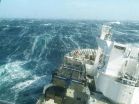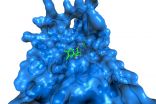From the year 2005, however, scientists pointed out that the Southern Ocean carbon sink might have begun to "saturate". Based on model results, they suggested that it had not increased since the late 1980s. This was unexpected as one had assumed that a direct relationship existed between the magnitude of the carbon sink and the concentration of atmospheric CO2: the higher the concentration of CO2 in the air, the greater the amount of CO2 absorbed by the sea.
Now the tables have turned. Since the beginning of the millennium the Southern Ocean carbon sink has become much stronger, thereby regaining its expected strength. This is demonstrated by an international research team led by Nicolas Gruber, a professor of environmental physics at ETH Zurich, and his postdoc Peter Landschützer in a study recently published in Science.
New statistical model closes data gap
For this study, the scientists analysed measurements of the concentration of CO2 in the surface waters of the Southern Ocean south of 35°S, from which the flux of CO2 across the air-sea interface can be computed. They also compared the resulting fluxes with estimates based on measurements of atmospheric CO2.
The surface CO2 concentration of the Southern Ocean is being measured by research vessels or by specially equipped merchant ships as they travel along the major trade routes. The sampling and subsequent analysis is internationally standardised and coordinated, but data coverage depends on each ship's actual itinerary. As a result, certain regions of the ocean are very well sampled, while there are also regions for which essentially no observations exist.
The researchers used a newly developed method based on neural networks to create a statistical model of the oceanic CO2 concentrations and then used this model to fill in the gaps. To this end, they also made use of satellite observations of sea water temperature, of salinity and of the chlorophyll content.
Carbon sink reinvigorated
The interpolated surface ocean CO2 data and the estimates based on atmospheric CO2 data clearly demonstrate that the Southern Ocean carbon sink began to revive around 2002. By 2010, its carbon uptake was once again comparable to the level expected on the basis of atmospheric CO2 increase alone.
An important conclusions that Gruber draws from this study is that the strength of the Southern Ocean carbon sink fluctuates strongly, possibly in periodic cycles, rather than increasing monotonically in response to the growth in atmospheric CO2. "We were surprised to see such large variations in this ocean's net carbon uptake," he says.
Overall weather patterns influence carbon uptake
Gruber and Landschützer and their team attribute the reinvigoration of the carbon sink above all to changes in the prevailing weather patterns in the studied region. Since the turn of the millennium, the dominant atmospheric pressure systems have exhibited an increasingly asymmetrical distribution. A powerful high pressure system has built up above the Atlantic sector of the Southern Ocean, while a distinct area of low pressure has formed over the Pacific sector.
The air pressure gradient between these regions of high and low air pressure has caused wind patterns to change. Winds now tend to blow in an undulating pattern, whereas in the 1990s they mainly blew straight from the west to the east. In the 1990s these winds were also stronger over much of the Southern Ocean, causing more water to be upwelled to the surface from depth. Since these deeper waters contain higher concentrations of dissolved CO2, this upwelling led to an anomalous release of this greenhouse gas into the atmosphere, resulting in a stagnation or even a decrease in the ocean's net carbon uptake.
Anomalous outgassing halted
Since the turn of the millennium, upwelling has generally subsided in all sectors apart from the Pacific, halting this anomalous release of stored CO2 into the atmosphere. But the winds have also changed the temperature of the surface water. By bringing warm air from subtropical latitudes into the South Atlantic they have warmed the surface waters of the South Atlantic substantially. At the same time, the anomalous low pressure system in the South Pacific brought exceptionally cold air from the interior of the Antarctic continent to this sector of the Southern Ocean, leading to a strong cooling there.
Together, the wind and temperature changes explain much of the reinvigoration of the Southern Ocean carbon sink. The cooling of surface waters in the Pacific sector enables them to absorb more CO2. In the Atlantic sector, on the other hand, changes in the wind-driven circulation patterns are likely responsible for the higher oceanic uptake of atmospheric CO2. Normally, this sector of the Southern Ocean is characterised by a significant upwelling of deeper waters, which increases the amount of dissolved inorganic carbon in the surface layer, thus counteracting the uptake from the atmosphere. The weakening of this upwelling system in recent years now enables the upper ocean to absorb more CO2.
Future trends cannot be predicted reliably
At present, the two researchers are unable to predict how the net carbon uptake of the Southern Ocean is likely to evolve in the future. "Our statistical model is not able to predict the future development," says Landschützer, "so it is very critical to continue measuring the surface ocean CO2 concentrations in the Southern Ocean. "This is particularly important since current models are not able to reproduce the observed variations", adds Gruber. Hence, long-term datasets are the only reliable means for determining the future evolution of the ocean's sink for carbon.
Another factor that is not yet fully understood is the effect of large-scale climate phenomena such as El Niño and La Niña on the Southern Ocean carbon sink. It is particularly noticeable that the reinvigoration of the carbon sink coincides with a period of prevalent La Niña conditions, i.e., relatively cool sea surface temperatures in the Pacific. The reinvigoration of the ocean's carbon sink also occurred during a period when global air temperatures have changed very little - the so-called climate warming hiatus - possibly related to a stronger heat uptake by the ocean.
INFORMATION:
Reference:
Landschützer P, Gruber N, Haumann FA, Rödenbeck C, Bakker DCE, van Heuven S, Hoppema M, Metzl N, Sweeney C, Takahashi T, Tilbrook B, Wankinkhof R. The Reinvigoration of the Southern Ocean Carbon Sink. Science, Online Publication, 11. September 2015. DOI: 10.1126/science.aab2620

